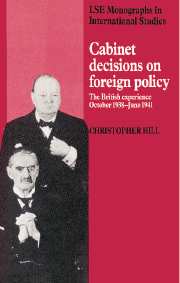Book contents
- Frontmatter
- Contents
- List of figures
- List of tables
- Acknowledgements
- Preface
- 1 Cabinets, foreign policies and case-studies
- 2 Constructing the Polish Guarantee, 15–31 March 1939
- 3 The Soviet question, April–August 1939
- 4 Entry into war, 1–3 September 1939
- 5 Reacting to the ‘peace offensive’, October 1939
- 6 To continue alone? May–July 1940
- 7 The longer term: War Aims and other committees, October 1940–June 1941
- 8 Decision-making in Cabinet
- Appendix 1 The Chamberlain Cabinet, 31 October 1938–3 September 1939
- Appendix 2 Attendance at the Foreign Policy Committee of the Cabinet, 14 November 1938–25 August 1939
- Appendix 3 Neville Chamberlain's statement in the House of Commons, 12 October 1939
- Appendix 4 Lord Halifax's paper for the War Aims Committee, October 1940
- Appendix 5 Anthony Eden's speech at the Mansion House, 29 May 1941 (extract)
- Notes
- Bibliography
- Index
- LSE MONOGRAPHS IN INTERNATIONAL STUDIES
5 - Reacting to the ‘peace offensive’, October 1939
Published online by Cambridge University Press: 02 February 2010
- Frontmatter
- Contents
- List of figures
- List of tables
- Acknowledgements
- Preface
- 1 Cabinets, foreign policies and case-studies
- 2 Constructing the Polish Guarantee, 15–31 March 1939
- 3 The Soviet question, April–August 1939
- 4 Entry into war, 1–3 September 1939
- 5 Reacting to the ‘peace offensive’, October 1939
- 6 To continue alone? May–July 1940
- 7 The longer term: War Aims and other committees, October 1940–June 1941
- 8 Decision-making in Cabinet
- Appendix 1 The Chamberlain Cabinet, 31 October 1938–3 September 1939
- Appendix 2 Attendance at the Foreign Policy Committee of the Cabinet, 14 November 1938–25 August 1939
- Appendix 3 Neville Chamberlain's statement in the House of Commons, 12 October 1939
- Appendix 4 Lord Halifax's paper for the War Aims Committee, October 1940
- Appendix 5 Anthony Eden's speech at the Mansion House, 29 May 1941 (extract)
- Notes
- Bibliography
- Index
- LSE MONOGRAPHS IN INTERNATIONAL STUDIES
Summary
The next of our case-studies is at once discrete from and powerfully connected to the drama we have just left. In the first half of October 1939, Chamberlain's government faced an uncomfortably new kind of problem, albeit one with echoes of Munich, namely the ‘peace offensive’. This was the term, the politicaljargon of the time,1 for the next stage in Hitler's strategy after the subjugation of Poland. From quite early on in September 1939, British decision-makers began to expect, even to fear, that the Fuhrer would try to lure them once more to the conference table, with all the humiliations that now implied. This was both an acknowledgement that the Allies were not about to take the military offensive and plunge the whole of Europe into war and an indication of the fact, pointed out by Clausewitz at the end of another great war, that politics and diplomacy did not cease in wartime.
On the surface, this should not have posed a major problem. The momentous decision to fight had been made only two or three weeks before, and the political world in London was more inclined to criticise the delays of 1–2 September than the fact of being at war. Moreover nothing had happened militarily or diplomatically to precipitate any rethinking – at least, in principle.
Yet reason alone is usually a poor guide to politics and in the febrile atmosphere of the first weeks of war, psychological factors played a large part in determining ministers' attitudes.
- Type
- Chapter
- Information
- Cabinet Decisions on Foreign PolicyThe British Experience, October 1938–June 1941, pp. 100 - 145Publisher: Cambridge University PressPrint publication year: 1991



